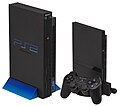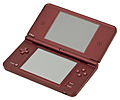User:GeneticOS/sandbox
Home Video Game Consoles[edit]
This is a list of home video game consoles in chronological order. This list includes the very first home video game consoles ever created, such as first generation Pong consoles, from the first ever cartridge console Odyssey, ranging from the major video game companies such as Atari, Nintendo, Sega, Sony, Microsoft to secondary market consoles. The list is divided into eras which are named based on the dominant console type of the era, though not all consoles of those eras are of the same type. Some eras are referred to based on how many bits a major console could process. The 128-bit era (sixth generation) was the final era in which this practice was widespread.[citation needed]
This list does not include other types of video game consoles such as handheld game consoles, which are usually of lower computational power than home consoles due to their smaller size, as well as microconsoles and dedicated consoles. Consoles have been redesigned from time to time to improve their market appeal. Redesigned models are not listed on their own.
First generation (1972–1980)[edit]
-
Magnavox Odyssey, released in 1972, was the first home video game console.
| Name | Release date | Manufacturer |
|---|---|---|
| Magnavox Odyssey | August 1972 | Magnavox |
| PC-50X Family | 1975 | General Instrument |
| Tele-Spiel | 1975 | Philips |
| Video 2000 | 1975 | Interton |
| Philips Odyssey | 1976 | Philips |
- Consoles of the early 1970s, such as Pong and Magnavox Odyssey were often inaccurately called "analog" but were actually discrete logic circuits.[1]
Second generation (1976–1983)[edit]
-
Fairchild Channel F (1976)
-
Fairchild Channel F II (1979)
-
RCA Studio II (1977)
-
Atari 2600 (1977)
-
Bally Astrocade (1977)
-
VC 4000 (1978)
-
Magnavox Odyssey 2 (1978)
-
Intellivision (1980)
-
VTech CreatiVision (1981)
-
Epoch Cassette Vision (1981)
-
Arcadia 2001 (1982)
-
Atari 5200 (1982)
-
ColecoVision (1982)
-
Vectrex (1982)
Third generation (1983–1993)[edit]
-
Atari 7800 (1984)
-
Sega Master System (1985)
-
Super Cassette Vision (1984)
-
PV-1000 (1983)
-
Action Max (1987)
| Name | Release date | Manufacturer |
|---|---|---|
| RDI Halcyon | 1985 | RDI Video Systems |
| PV-1000 | 1983 | Casio |
| Commodore 64 Games System | 1990 | Commodore |
| Amstrad GX4000 | 1990 | Amstrad |
| Atari 7800 | 1984 | Atari Corporation |
| Atari XEGS | 1987 | Atari Corporation |
| Sega SG-1000 (Various Models) | 1983 | Sega |
| Sega Master System (Various Models) | 1985 | Sega |
| Nintendo Entertainment System (NES) / Famicom (Various Models) | 1983 | Nintendo |
| C1 NES TV / Sharp Nintendo Television | 1983 | Nintendo |
| NES-101 / AV Famicom | 1993 | Nintendo |
| Family Computer Disk System (Japan only) | 1986 | Nintendo ‹| | Home console add-on› |
| Super Cassette Vision | 1984 | Epoch |
| Zemmix | 1985 | Daewoo Electronics |
| Bridge Companion | 1985 | BBC / Heber |
| Atari 2600 Jr. | 1986 | Atari Inc. |
| VideoSmarts | 1986 | VTech |
| Action Max | 1987 | Worlds of Wonder |
| Video Challenger | 1987 | Tomy |
| Video Art | 1987 | LJN |
Fourth generation (1987–1995)[edit]
-
TurboGrafx-16 (1987)
-
Sega Genesis (1988)
-
Neo-Geo (1990)
-
Neo-Geo CD (1994)
-
CD-i (1991)
| Name | Release date | Manufacturer |
|---|---|---|
| Sega CD / Mega CD (Various Models) | 1992 (N. America) | Sega ‹| Home console add-on › |
| Sega 32X | 1994 | Sega <| Home console add-on > |
| Sega Genesis / Mega Drive (Various Models) | 1988 | Sega |
| Sega Pico | 1994 | Sega |
| PC Engine / TurboGrafx-16 (Various Models) | 1987 | NEC |
| PC Engine2 / SuperGrafx | 1989 | NEC |
| Interactive Vision | 1988 | View-Master Ideal Group Inc. |
| Socrates | 1988 | VTech |
| Terebikko | 1988 | Bandai |
| Konix Multisystem | Unreleased | Konix |
| Neo-Geo | 1990 | SNK |
| Neo-Geo CD | 1994 | SNK |
| Neo-Geo CDZ | 1994 | SNK |
| Commodore CDTV | 1991 | Commodore |
| Memorex VIS | 1992 | Memorex |
| Super Nintendo Entertainment System (SNES) / Super Famicom (Various Models) | 1990 | Nintendo |
| SF-1 SNES TV (Japan Only) | 1990 | Nintendo |
| SNES 2 / Super Famicom Jr. | 1997 | Nintendo |
| SNES-CD | Cancelled | Nintendo |
| Satellaview (Japan Only) | 1993 | Nintendo ‹| Home console add-on › |
| CD-i | 1991 | Philips |
| TurboDuo / PC Engine Duo | 1991 | NEC |
| Super A'Can | 1995 | Funtech |
Fifth generation (1993–1999)[edit]
-
Pioneer LaserActive (1993)
-
FM Towns Marty (1993)
-
Atari Jaguar (1993)
-
PlayStation (1994)
-
Sega Saturn (1994)
-
3DO Interactive Multiplayer (1993)
-
Nintendo 64 (1996)
-
Amiga CD32 (1993)
-
PC-FX (1994)
| Name | Release date | Manufacturer |
|---|---|---|
| Pioneer LaserActive | 1993 | Pioneer Corporation |
| FM Towns Marty | 1993 | Fujitsu |
| Apple Bandai Pippin | 1995 | Bandai |
| PC-FX | 1994 | NEC |
| Atari Panther | Cancelled | Atari Corporation |
| Atari Jaguar | 1993 | Atari Corporation |
| Atari Jaguar CD | 1995 | Atari Corporation ‹| Home console add-on › |
| PlayStation | 1994 | Sony |
| Net Yaroze | 1997 | Sony |
| Sega Saturn | 1994 | Sega |
| 3DO Interactive Multiplayer | 1993 | Panasonic |
| Amiga CD32 | 1993 | Commodore |
| Casio Loopy | 1995 | Casio |
| Playdia | 1994 | Bandai |
| CPS Changer | 1994 | Capcom |
| Nintendo 64 | 1996 | Nintendo |
| Nintendo 64DD | 1999 | Nintendo ‹| Home console add-on › |
| Sega Neptune | Cancelled | Sega |
Sixth generation (1999–2007)[edit]
-
Dreamcast (1998 (in Japan) 1999 (in other areas))
-
PlayStation 2 (2000).
-
Nintendo GameCube (2001)
-
Xbox (2001)
| Name | Release date | Manufacturer | Units sold |
|---|---|---|---|
| Dreamcast | 1999 | Sega |
|
| Nuon | 2000 | VM Labs |
|
| PlayStation 2 | 2000 | Sony |
|
| Atari Jaguar II | Cancelled | Atari Corporation |
|
| L600 | Cancelled | Indrema | |
| MoMA Eve | Cancelled | Via | |
| GameCube | 2001 | Nintendo |
|
| Game Boy Player | 2003 | Nintendo ‹| Home console add-on › |
|
| iQue Player | 2003 | Nintendo |
|
| Panasonic M2 | Cancelled | Panasonic |
|
| Panasonic Q/Q Game Boy Player | 2001 | Nintendo |
|
| Xbox | 2001 | Microsoft |
|
| PSX | 2003 | Sony |
|
| XaviX Port | 2004 | SSD Company | |
| DISCover | 2004 | Digital Interactive Systems Corporation | |
| Leapster TV | 2005 | LeapFrog |
|
| V.Smile | 2005 | VTech |
|
| GoGo TV Video Vision | 2005 | Manley |
|
| Buzztime Home Trivia System | 2005 | NTN Buzztime |
|
| Sega Beena | 2005 | Sega |
Seventh generation (2005-2012)[edit]
-
Xbox 360 (2005)
-
PlayStation 3 (2006)
-
Wii (2006)
| Name | Release date | Manufacturer | Units sold |
|---|---|---|---|
| Phantom | Cancelled | Phantom |
|
| Game Wave | 2005 | ZAPiT |
70 thousand(as of 2008)[2] |
| Xbox 360 | 2005 | Microsoft |
83.7 million(as of March 31, 2014[update])[3][4][5][6] |
| HyperScan | 2006 | Mattel |
|
| ION | 2006 | Playskool |
|
| Wii | 2006 | Nintendo |
101.06 million(as of March 31, 2014)[7] |
| PlayStation 3 | 2006 | Sony |
80 million[8] |
| I Can Play Piano | 2006 | Fisher-Price |
|
| V.Flash | 2006 | VTech |
|
| V.Smile V-Motion | 2008 | VTech |
|
| V.Smile Baby | 2009 | VTech |
|
| Vmigo TV Docking System | 2006 | Jakks Pacific |
|
| Telestory | 2006 | Jakks Pacific |
|
| Clickstart My First Computer | 2007 | LeapFrog |
|
| I Can Play Guitar | 2007 | Fisher-Price |
|
| Smart Cycle | 2007 | Fisher-Price |
|
| EVO Smart Console | 2008 | Envizions | Low hundreds[9] |
| Retro Duo | 2008 | Retrobit
‹| Clone console › |
|
| Sega Firecore | 2009 | AtGames ‹| Clone console › |
|
| Zippity | 2009 | LeapFrog |
|
| Sega Zone | 2010 | Atgames ‹| Clone console ›| | |
| Eedoo CT510 | 2012 | Lenovo |
Eighth generation (2012–present)[edit]
-
Wii U (2012)
-
PlayStation 4 (2013)
-
Xbox One (2013)
-
Ouya (2013)
This article needs additional citations for verification. (September 2014) |
| Name | Release date | Manufacturer | Units Sold |
|---|---|---|---|
| Wii U | 2012 | Nintendo |
6.68 million(as of June 30, 2014) |
| PlayStation 4 | 2013 | Sony |
|
| Steam Machine | TBA | Valve |
|
| Xbox One | 2013 | Microsoft |
|
| Piston | 2013 | Xi3 | |
| RetroN 5 | 2014 | Hyperkin
‹| Clone console ›| | |
| LeapTV | 2014 | LeapFrog |
|
| OTON X | 2014 | EnGeniux |
See also[edit]
References[edit]
- ^ Bub, Andrew (June 7, 2005). "The Original GamerDad: Ralph Baer". http://www.gamerdad.com. Archived from the original on 2008-12-07. Retrieved February 23, 2010.
{{cite web}}: External link in|publisher= - ^ "VP Final - MP4". YouTube. 2008-12-20. Retrieved 2012-08-14.
- ^ "Earnings Release FY13 Q4". Microsoft. Retrieved May 7, 2014.
- ^ "Earnings Release FY14 Q1". Microsoft. Retrieved May 7, 2014.
- ^ "Earnings Release FY14 Q2". Microsoft. Retrieved May 7, 2014.
- ^ "Earnings Release FY14 Q3". Microsoft. Retrieved May 7, 2014.
- ^ "Top Selling Software Sales Units". Nintendo Co., Ltd. March 31, 2014. Retrieved May 7, 2014.
- ^ "PlayStation 3 Sales Reach 80 Million Units Worldwide". Sony Computer Entertainment. Retrieved November 6, 2013.
- ^ "Crowdfunding and the Mysterious Oton Console". Tap-Repeatedly. Retrieved 2012-12-30.
Category:Home video game consoles Home video game consoles
Handheld Consoles[edit]
This is a list of handheld game consoles, portable video game consoles with a built-in screen and game controls and separate games.
For handheld dedicated consoles, which only play games built into the system, see list of dedicated consoles.
Consoles[edit]
| Console | Release date(s) | Discontinuation date(s) | Manufacturer | Generation | Notes | Picture |
|---|---|---|---|---|---|---|
| Microvision | 1979 | Milton Bradley | Second |
|

| |
| Epoch Game Pocket Computer | 1984 | Epoch | Second |
|

| |
| Game Boy |
|
Nintendo | Fourth |
|

| |
| Atari Lynx |
|
1996 | Atari | Fourth |
|

|
| Sega Game Gear | Sega | Fourth |
|
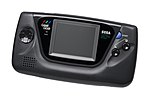
| ||
| TurboExpress | 1990 | NEC | Fourth |
|

| |
| Gamate | 1990 | 1993 | Bit Corporation | Fourth |
|
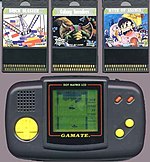
|
| Game Master | 1990 | Hartung | Fourth |
|
File:Hgm front-1-.jpg | |
| Watara Supervision | 1992 | Watara | Fourth |
|

| |
| Mega Duck | 1993 | Welback Holdings | Fourth |
|

| |
| Virtual Boy | Nintendo | Fifth |
|
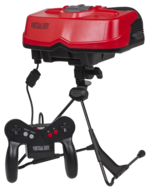
| ||
| Sega Nomad | Sega | Fifth |
|
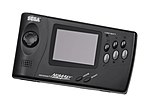
| ||
| Design Master Senshi Mangajukuu | 1995 | Bandai | Fifth |
|
||
| R-Zone | 1995 | Tiger Electronics | Fifth |
|

| |
| Game.com | September 1997 | 2000 | Tiger Electronics | Fifth | 
| |
| Neo Geo Pocket | 2001 | SNK | Fifth |
|

| |
| WonderSwan |
|
2003 | Bandai | Sixth | 
| |
| Game Boy Advance | Nintendo | Sixth |
|

| ||
| N-Gage | October 7, 2003 | Nokia | Sixth | 
| ||
| Tapwave Zodiac | October 2003 | July 2005 | Tapwave | Sixth |
|

|
| GP32 | Game Park | Sixth |
|

|
Gallery[edit]
-
Timetop GameKing
2003 -
Nintendo DS
2004 -
Nintendo DS Lite
2006 -
Sony PSP Slim & Lite
2007 -
GPH GP2X F200
2007 -
Nintendo DSi
2008 -
Dingoo A320
2009 -
GPH GP2X Wiz
2009 -
Sony PSP Go
2009 -
Nintendo DSi XL
2009 -
Pandora
2010 -
Nintendo 3DS
2011 -
Sony PlayStation Vita
2012
See also[edit]
- List of best-selling game consoles
- List of video game console emulators
- Comparison of handheld game consoles
- List of video game consoles
References[edit]
- ^ White, Dave (July 1989). "Gameboy Club". Electronic Gaming Monthly. No. 3. p. 68.
- ^ "retrodiary: 1 April – 28 April". Retro Gamer (88). Bournemouth: Imagine Publishing: 17. April 2011. ISSN 1742-3155. OCLC 489477015.
- ^ "Consolidated Sales Transition by Region". Nintendo. 2010-01-27. Archived from the original (PDF) on 2010-02-14. Retrieved 2010-02-14.
- ^ "Consolidated Sales Transition by Region". Nintendo. 2010-01-27. Archived from the original (PDF) on 2010-02-14. Retrieved 2010-02-14.
- ^ a b c d e f g h i j k Snow, Blake (2007-07-30). "The 10 Worst-Selling Handhelds of All Time". GamePro. Archived from the original on 2007-10-12. Retrieved 2008-01-17.
- ^ a b "Retroinspection: Sega Game Gear". Retro Gamer (41). Imagine Publishing: 78–85. 2009. ISSN 1742-3155.
- ^ Forster, Winnie (2005). The Encyclopedia of Game.Machines: Consoles, Handhelds, and Home Computers 1972-2005. Magdalena Gniatczynska. p. 139. ISBN 3-0001-5359-4.
- ^ a b c "Sega Game Gear". Retro Gamer (17). Live Publishing: 26–35. 2005. ISSN 1742-3155.
- ^ a b Beuscher, David. "Sega Game Gear - Overview". Allgame. All Media Network. Archived from the original on 2014-09-14. Retrieved 2013-07-08.
- ^ Blake Snow (2007-05-04). "The 10 Worst-Selling Consoles of All Time". GamePro.com. Archived from the original on 2007-05-08. Retrieved 2007-11-25.
- ^ a b Marriott, Scott Alan. "Sega Genesis Nomad - Overview". Allgame. All Media Network. Archived from the original on 2014-09-14. Retrieved 2013-10-05.
- ^ Wild, Kim (2007). "Retroinspection: WonderSwan". Retro Gamer (36): 68–71. ISSN 1742-3155.
- ^ Brunskill, Kerry (2010). "Swan Song: A WonderSwan Retrospective". Retro Gamer (126): 45–47.
- ^ Fielder, Lauren (May 16, 2001). "E3 2001: Nintendo unleashes GameCube software, a new Miyamoto game, and more". GameSpot. Retrieved July 19, 2014.
- ^ "Game Boy Advance: It's Finally Unveiled". IGN. August 23, 2000. Retrieved July 19, 2014.
- ^ Bramwell, Tom (March 21, 2001). "GBA Day: June 22nd". Eurogamer. Retrieved July 19, 2014.
- ^ "Consolidated Sales Transition by Region" (PDF). Nintendo. 2010-07-28. Retrieved 2014-07-19.
Category:Handheld game consoles Handheld game consoles
microconsoles[edit]
This is a list of microconsoles in chronological order. This list includes the very first microconsoles ever created to the present.
The microconsole market started in the seventh generation era of video game consoles, in parallel with other types of video game consoles in the same era.
Seventh generation (2005-2012)[edit]
| Name | Release date | Manufacturer |
|---|---|---|
| Zeebo | 2009 | Zeebo Inc. |
| OnLive | 2010 | OnLive |
| Co-Star | 2012 | VIZIO |
Eighth generation (2012–present)[edit]
| Name | Release date | Manufacturer |
|---|---|---|
| Ouya | 2013 | Ouya Inc. (formerly Boxer8) |
| Pandora TV Box | 2013 | N/A |
| G-cluster | 2013 | G-cluster Global |
| GameStick | 2013 | PlayJam |
| MOJO | Q3 2013 | Mad Catz |
| GamePop | Q4 2013 | BlueStacks |
| PlayStation TV | 2013 | Sony |
| flarePlay | 2013 | flarePlay |
| Xtreamer Multi-Console | 2014 | Unicorn Information Systems |
| FunBox | 2014 | ZTE |
| TE | 2014 | TimeTop |
| MK-300 / G10 / K3 | 2014 | Movka |
| Fire TV | 2014 | Amazon.com |
| T2 | 2014 | TCL |
| Tron | 2014 | Huawei |
| Shadow Stick 3 | 2014 | Baidu |
| Nexus Player | 2014 | Google |
| Razer Microconsole | TBA | Razer |
| Game Box | TBA | ASUS |
| Z6C | TBA | Zero Devices |
See also[edit]
References[edit]
Category:Microconsoles Microconsoles
Dedicated consoles[edit]
This is a list of dedicated consoles in chronological order. This list includes the very first dedicated consoles ever created to the present.
Most of the first generation video game consoles are dedicated consoles. There was a silence in the dedicated console market since then until recent years, when they appear again often acting as a repackaging and rebranding of older generation game content.
First generation (1972–1980)[edit]
-
Color TV Game, released only in Japan in 1977.
-
Telstar (1976)
-
APF TV Fun (1976)
| Name | Release date | Manufacturer |
|---|---|---|
| Ping-o-Tronic | 1974[1] | Zanussi |
| Telstar | 1976 | Coleco |
| Sear Tele-Games | 1975 | Atari |
| Video Pinball | 1978 | Atari |
| Stunt Cycle | 1977 | Atari |
| APF TV Fun | 1976 | APF |
| Sportsman T101 | 1976 | Unisonic |
| Tournament 100 | 1976 | Unisonic |
| Tournament 102 | 1976 | Unisonic |
| Tournament 150 | 1976 | Unisonic |
| Tournament 200 | 1976 | Unisonic |
| Tournament 1000 | 1977 | Unisonic |
| Tournament 2000 | 1977 | Unisonic |
| Tournament 2501 | 1977 | Unisonic |
| Olympian 2600 | 1978 | Unisonic |
| Radio Shack TV Scoreboard | 1976 | Radio Shack |
| Colorsport VIII | 1978 | Granada |
| Binatone TV Master Mk IV | 1977[2] | Binatone |
| Color TV Game 6 (Japan only) | 1977 | Nintendo |
| Color TV Game 15 (Japan only) | 1978 | Nintendo |
| Color TV Racing 112 (Japan only) | 1978 | Nintendo |
| Color TV Game Block Breaker (Japan only) | 1979 | Nintendo |
| Computer TV Game (Japan only) | 1980 | Nintendo |
| Wonder Wizard | 1976 | GHP |
| BSS 01 (GDR only) | 1980 | VEB Kombinat Mikroelektronik Erfurt |
| TV játék | 1980 | Videoton |
Second generation (1976–1992)[edit]
| Name | Release date | Manufacturer |
|---|---|---|
| Game & Watch series | 1980-1991 | Nintendo |
Sixth generation (1999–2007)[edit]
| Name | Release date | Manufacturer | Units sold |
|---|---|---|---|
| Atari Flashback | 2004 | Atari |
|
| Atari Flashback 2 | 2005 | Atari Inc. |
860 thousand[3] |
Seventh generation (2005-2012)[edit]
| Name | Release date | Manufacturer | Units sold |
|---|---|---|---|
| Atari Flashback 3 | 2011 | AtGames |
|
| Atari Flashback 4 | 2012 | AtGames |
See also[edit]
References[edit]
- ^ Tristan, Donovan (2010). "Hardware Glossary". Replay, The History Of Video Games. Yellow Ant. ISBN 978-0-9565072-2-8.
- ^ http://www.old-computers.com/museum/computer.asp?st=3&c=1035
- ^ Vendel, Curt. "The Escapist : Curt Vendel: The Escapist Interview". The Escapist. Retrieved 8 May 2014.






































